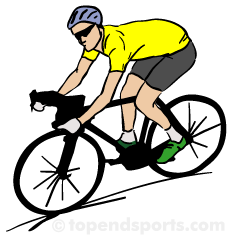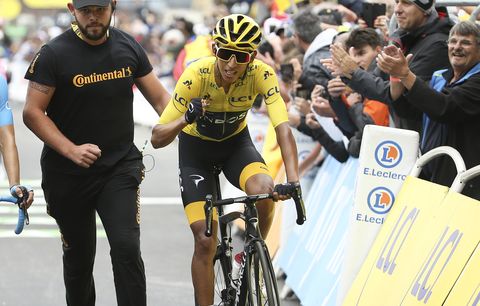Polka Dot Jersey Winners
Sports Quiz / Polka Dot jersey winners Tour de France Random Sports or Country Quiz Can you name the Polka Dot jersey winners in the Tour de France?
- 2020 Tour de France results for the yellow jersey, green jersey, white jersey and polka-dot jersey Overall (Yellow Jersey) 1. Tadej Pogacar (SLO) — 87:20:05.
- Daniel Teklehaimanot of Eritrea and MTN-Qhubeka celebrates as he is awarded the polka-dot jersey. (CNN) He has already made Tour de France history as one of the first African-registered team ever.
- Winner of the Criterium du Dauphine 2017 Denmark's Jakob Fuglsang, Netherlands' Koen Bouwman wearing the best climber's polka dot jersey, Germany's. France's Julian Alaphilippe, wearing the best climber's polka dot jersey, celebrates on the podium after winning the 16th stage of the 105th edition.

In road bicycle racing (e.g. Grand Tour stage races) the green jersey is a distinctive racing jersey worn by the most consistent highest finisher in the competition.[1]
While the overall race leader in the Tour de France will wear the yellow jersey, or 'maillot jaune', the green jersey ('maillot vert') will be worn by the leader in the points competition. Since 2009, the Vuelta a España has also used the green jersey to signify the leader of the points competition. In the Giro d'Italia, the green jersey was, from 1974 to 2011, worn by the King of the Mountains, the leader in the competition for climbing specialists.
Classification guide[edit]
The following events use the 'green jersey' to signify the current leader and/or final winner of the overall classification by points (often known as the sprinters' competition):
- Tour de France (known as the 'maillot vert') (see also Points classification in the Tour de France)
- Vuelta a España[citation needed]
- Critérium du Dauphiné Libéré[citation needed]
- Tour de l'Avenir[citation needed]
- Tour de Georgia[citation needed]
- Tour de Romandie[citation needed]
- Tour of Ireland[citation needed]
- Tour of California (known as the 'sprints classification')[citation needed]
Mountains competition leader[edit]
The following events have used the 'green jersey' to signify the current leader and/or final winner of the overall classification of the best climber (often known as the King of the Mountains competition):
- Giro d'Italia (Italian: known as the maglia verde: 1974 to 2011) (see also Mountains classification in the Giro d'Italia)
- Tour de Pologne (Polish: known as the najlepszy góral or Klasyfikacja Górska)[citation needed]
- Vuelta a España (prior to 2008)[citation needed]
As of 2009, no major race uses the 'green jersey' to signify the current leader and/or final winner of the overall classification of sprinter where the polka dot jersey represents the king of the mountain.[citation needed]
References[edit]
- ^David Clark Scott (9 July 2010). 'Tour de France 101: What do different color jerseys mean?'. The Christian Science Monitor. Retrieved 15 October 2014.
Despite a delay of over two months from its intended start date in late June, the 107th edition of the Tour de France returns to the French countryside beginning Aug. 29. The 23-day, 21-stage race winding 3,470 kilometers (2,156 miles) remains the same, but the COVID-19 pandemic means it will be a race like no other.
This year's edition departs from Nice and comes to its ceremonial finish in Paris over three weeks later. The route feature eight mountain stages with four summit finishes, nine flat stages, three hilly stages, and one individual time trial on the penultimate day.
2019 winner Egan Bernal returns with Team Ineos and looks to claim his second Tour de France victory. He is the first Colombian to ever win the title and was the third-youngest rider ever to do so at the age of 22 years and 196 days.
In an unexpected shakeup, both four-time champion Chris Froome and 2018 Tour de France winner Geraint Thomas were left off of Ineos and will watch the race from home. An updated list of stage winners, the most recent stage standings and what the colored jerseys that riders are wearing can be found below.
MORE: Watch the Tour de France live with fuboTV (7-day free trial)
Tour de France standings 2020
| 1. Primoz Roglic (Slovenia)— 42 hours, 15 minutes, 23 seconds |
| 2. Egan Bernal (Colombia) — +00.00.21 |
| 3. Guillaume Martin (France) — +00.00.28 |
| 4. Romain Bardet (France) — +00.00.30 |
| 5. Nairo Quintana (Colombia) — +00.00.32 |
You can find a full list of classifications here.
Tour de France winners, results by stage
The 2020 Tour de France sets off from Nice and ends 23 days later in the country's capital of Paris. Cyclists are given just two rest days during the taxing 3,470 km (2,156 mi.) journey.
| # | Date | Length | Stage | Winner |
| 1 | Aug. 29 | 156km (97 mi.) | Nice to Nice (flat) | Alexander Kristoff |
| 2 | Aug. 30 | 187km (116 mi.) | Nice to Nice (mountain) | Julian Alaphilippe |
| 3 | Aug. 21 | 198km (123 mi.) | Nice to Sisteron (flat) | Caleb Ewan |
| 4 | Sept. 1 | 157km (100 mi.) | Sisteron to Orcieres-Merlette (hilly) | Primoz Roglic |
| 5 | Sept. 2 | 183km (114 mi.) | Gap to Privas (flat) | Wout van Aert |
| 6 | Sept. 3 | 191km (119 mi.) | Le Teil to Mont Aigoual (hilly) | Alexey Lutsenko |
| 7 | Sept. 4 | 168km (104 mi.) | Millau to Lavaur (flat) | Wout van Aert |
| 8 | Sept. 5 | 140km (88 mi.) | Cazeres-Sur-Garonne to Loudenvielle (mountain) | Nans Peters |
| 9 | Sept. 6 | 154km (95 mi.) | Pau to Laruns (mountain) | Tadej Pogacar |
| Rest day | Sept. 7 | |||
| 10 | Sept. 8 | 170km (105 mi.) | Ile D’Oleron to Ile de Re (flat) | Sam Bennett |
| 11 | Sept. 9 | 167km (104 mi.) | Chatelaillon-Plage to Poitiers (flat) | - |
| 12 | Sept. 10 | 218km (135 mi.) | Chauvigny to Sarran (hilly) | - |
| 13 | Sept. 11 | 191km (119 mi.) | Chatel-Guyon to Puy Mary (mountain) | - |
| 14 | Sept. 12 | 197km (121 mi.) | Clermont-Ferrand to Lyon (flat) | - |
| 15 | Sept. 13 | 175km (108 mi.) | Lyon to Grand Colombier (mountain) | - |
| Rest day | Sept. 14 | |||
| 16 | Sept. 15 | 164km (102 mi.) | La Tour-Du-Pin to Villard-De-Lans (flat) | - |
| 17 | Sept. 16 | 168km (106 mi.) | Grenoble to Meribel (mountain) | - |
| 18 | Sept. 17 | 168km (109 mi.) | Meribel to La Roche-Sur-Foron (mountain) | - |
| 19 | Sept. 18 | 160km (103 mi.) | Bourg-En-Bresse to Champagnole (flat) | - |
| 20 | Sept. 19 | 36km (81 mi.) | Lure to La Planche Des Belles Filles (individual time trial) | - |
| 21 | Sept. 20 | 122km (76 mi.) | Mantes-La-Jolie to Paris (flat) | - |
What do the Tour de France jerseys mean?
While most casual cycling fans are familiar with the yellow jersey given to the rider with the lowest aggregate time prior to that day's stage, there are actually a handful of jersey colors and numbers that symbolize different meanings.
In total there are 176 riders representing 30 countries, racing for 22 different teams. Each team has its own custom jersey adorned with various sponsors, but a select few elite riders will not match their teammates. Below are what the special jerseys are and what they represent.
Yellow jersey
The familiar yellow jersey is known as the maillot jaune. This jersey indicates the cyclist with the lowest aggregate time prior to the start of that day's stage. Because the jersey is based on total time, it does not necessarily just go to the rider who won that day's stage. Last year's winner Egan Bernal wore the yellow jersey for just three stages.
Polka-dot jersey
A white jersey with red polka-dots is awarded to the 'King of the Mountains'.
Mountains are graded on steepness, length, and position on the course and given points corresponding to that grade. The first rider to crest the hills and mountains are then awarded the corresponding points. The first maillot à pois rouges was first worn in 1975.
Green jersey
The green jersey, or maillot vert, is the sprinter's jersey, given to the leader of the points classification.
The first 10-25 riders that cross the finish of that day's stage are awarded points depending on that stage's profile (i.e. flat, hilly, mountainous). Flatter courses produce more points, thereby leading to the association of a sprinter excelling on these routes.
Last year's winner of the green jersey Peter Sagan also holds the record for most times winning it (7). He has won the mailot vert seven of the last eight years.
White jersey
The maillot blanc goes to the best young rider. This jersey is worn by the fastest overall rider who is under age 25 on Jan. 1 of that year's race. Egan Bernal also won this jersey last year.
Other jerseys
Slightly less noticeable than the different colored jerseys are the different colored numbers some riders wear. The most combative rider of each stage — after every stage excluding time trials, a panel decides the day’s most aggressive rider — will wear a red number on a white background, instead of the usual black on white.
Cyclists with a black number on a yellow background represent riders of the team with the fastest three riders. They also have the option of wearing yellow helmets.
Additionally the reigning world champions of the road race and individual time trial wear a rainbow jersey in those respective stages of the Tour. These jersey consists of a white jersey with green, yellow, black, red and blue bands around it. This year's World Championships fall on the same day as the final stage of the Tour de France, meaning riders will have to decide which event to attend.
Tour de France records
With 106 years of history, there is plenty of time for countless records to rise and fall throughout the different iterations of the Tour de France. For starters, this is just the second time since World War II that the event has not been held in July.
Polka Dot Jersey Seattle
Eddy Merckx is the Michael Jordan of cycling having won a record 34 stages and five Tour de France titles. He is joined by Jacques Anquetil, Bernard Hinault and Miguel Indurain as the only-five time winners of the event.
Polka Dot Meaning
Merckx is also the only cyclist to win every category upon the completion of a Tour de France. In 1969 the Belgian cyclist was the King of the Mountains, won the combination classification, combativity award and points competition, and won the Tour.
While Merckx was the wearer of all the colored jerseys, twice the overall winner of the Tour de France never won the yellow jersey during the race - Jean Robic in 1947 and Jan Janssen in 1968.

Polka Dot Jersey Winner 2019
The greatest margin of victory is 28 minutes, 17 seconds, accomplished by Fausto Coppi in 1952. Greg LeMond's victory of eight seconds, over Laurent Fignon in 1989 remains the slimmest margin.